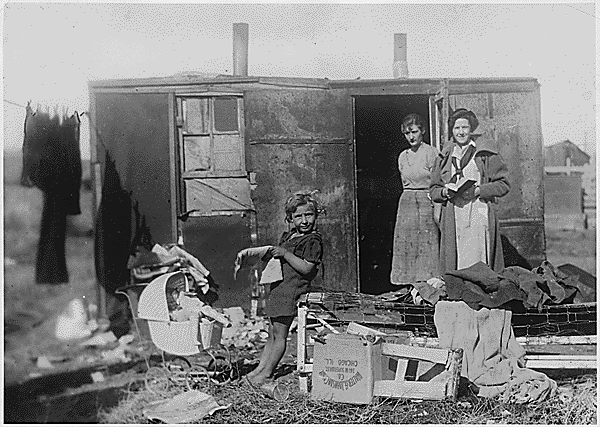
Many families in the Great Depression were too poor to afford housing. Some of them had gotten evicted, where even their family pictures were sold. They then moved to "Hoovervilles", areas of makeshift homes next to cities.
The name "Hooverville" mocked the president, Herbert Hoover. Hoovervilles were made up of scraps, including old tires, cardboard boxes, newspapers, and flattened metal. It was anything anyone could find, making it often unsafe for living. Garbage cans were a very important part of homeless living, because you could cook on the bottom, flatten it to make part of a house, or even, in some cases, sleep inside of it.
No two Hoovervilles were quite alike, and the camps varied in population and size. Some were as small as a few hundred people while others, in bigger metropolitan areas such as Washington, D.C., and New York City, boasted thousands of inhabitants. St. Louis, Missouri, was home to one of the country’s largest and longest-standing Hoovervilles.
Whenever possible, Hoovervilles were built near rivers for the convenience of a water source. For example, in New York City, encampments sprang up along the Hudson and East rivers. Some Hoovervilles were dotted with vegetable gardens, and some individual shacks contained furniture a family had managed to carry away upon eviction from their former home. However, Hoovervilles were typically grim and unsanitary. They posed health risks to their inhabitants as well as to those living nearby, but there was little that local governments or health agencies could do. Hooverville residents had nowhere else to go, and public sympathy, for the most part, was with them. Even when Hoovervilles were raided by order of parks departments or other authorities, the men who carried out the raids often expressed regret and guilt for their actions. More often than not, Hoovervilles were tolerated.
In addition to the term “Hooverville,” President Hoover’s name was used derisively in other ways during the Great Depression. For example, newspapers used to shield the homeless from the cold were called “Hoover blankets,” while empty pants pockets pulled inside out–demonstrating no coins in one’s pockets–were “Hoover flags.” When soles wore out of shoes, the cardboard used to replace them was dubbed “Hoover leather,” and cars pulled by horses because gas was an unaffordable luxury were called “Hoover wagons.”

Seattle's main Hooverville was one of the largest, longest-lasting, and best documented in the nation. It stood for ten years, 1931 to 1941. Covering nine acres of public land, it housed a population of up to 1,200, claimed its own community government including an unofficial mayor, and enjoyed the protection of leftwing groups and sympathetic public officials until the land was needed for shipping facilities on the eve of World War II. If you would like to see more pictures of the Hoovervilles in Washington State click here.
Watch as Herbert Hoover did too little too late to help turn around the economy.
This video talks about Hoovervilles.
Comment on the blog: How would you feel if you lost your home because your parents couldn't make the mortgage payment and you had to give up the family car?

